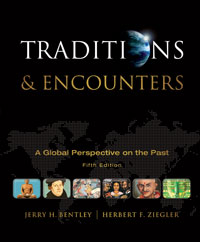
Traditions and Encounters, AP Edition (Bentley), 5th EditionChapter 13: The Expansive Realm of IslamOverviewThe religion of Islam emerged on the Arabian peninsula in the seventh century C.E. as a result of the vision and the teachings of Muhammad. His message attracted a rapidly expanding circle of devout believers, known as Muslims. After Muhammad's death, Arab conquerors spread the word of Islam throughout a vast territory extending from the Indus River to the Iberian peninsula within one century. This rapid expansion of Islam contributed to the development of a massive trade and communication network in which goods and ideas spread freely. The realm of Islam became one of the most prosperous and cosmopolitan societies of the postclassical world. This new society was characterized by the following:
|  |















